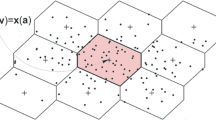Abstract
The GPS double difference carrier phase measurements are ambiguous by an unknown integer number of cycles. High precision relative GPS positioning based on short observational timespan data, is possible, when reliable estimates of the integer double difference ambiguities can be determined in an efficient manner. In this contribution a new method is introduced that enables very fast integer least-squares estimation of the ambiguities. The method makes use of an ambiguity transformation that allows one to reformulate the original ambiguity estimation problem as a new problem that is much easier to solve. The transformation aims at decorrelating the least-squares ambiguities and is based on an integer approximation of the conditional least-squares transformation. This least-squares ambiguity decorrelation approach, flattens the typical discontinuity in the GPS-spectrum of ambiguity conditional variances and returns new ambiguities that show a dramatic improvement in correlation and precision. As a result, the search for the transformed integer least-squares ambiguities can be performed in a highly efficient manner.
Similar content being viewed by others
References
Hatch, R. (1986): Dynamic Differential GPS at the Centimeter Level.Proceedings 4th International Geod. Symp. on Satellite Positioning, Austin, Texas, 28 April – 2 May, pp. 1287–1298.
Hofmann-Wellenhof, B., B.W. Remondi (1988): The Antenna Exchange: one Aspect of High-Precision Kinematic Survey. Presented at the International GPS Workshop,GPS Techniques Applied to Geodesy and Surveying, Darmstadt, FRG, 10–13 April.
Remondi, B.W. (1984):Using the Global Positioning System (GPS) Phase Observable for Relative Geodesy: Modelling, Processing, and Results, Ph.D. dissertation, NOAA, Rockville, 360 pp..
Seeber, G. G. Wübbena (1989): Kinematic Positioning with Carrier Phases and “On the Way” Ambiguity Solution.Proceedings 5th Int. Geod. Symp. on Satellite Positioning. Las Cruces, New Mexico, March 1989.
Frei, E., G. Beutler (1990): Rapid Static Positioning Based on the Fast Ambiguity Resolution Approach FARA: Theory and First Results.Manuscripta Geodaetica, Vol. 15, No. 6, 1990.
Blewitt, G.(1990): A New Tool for Dense Monitoring of Crustal Strain: GPS Rapid Static Surveying.EOS Transaction American Geophysical Union, Vol. 71, No. 17, p. 483.
Euler, H.-J., C. Goad (1990): On Optimal Filtering of GPS Dual Frequency Observations without using Orbit Information.Bulletin Geodesique, Vol. 65, pp. 130–143.
Kleusberg, A. (1990): A Review of Kinematic and Static GPS Surveying Procedures.Proceedings of the Second International Symposium on Precise Positioning with the global Positioning system, Ottawa, Canada, September 3–7 1990, pp. 1102–1113.
Counselman, C.C., S.A. Gourevitch (1981): Miniature Interferometer Terminals for Earth Surveying: Ambiguity and Multipath with Global Positioning System.IEEE Transactions on Geoscience and Remote Sensing, Vol. GE-19, No. 4, pp. 244–252.
Hatch, R. (1989): Ambiguity Resolution in the Fast Lane. ProceedingsION GPS-89, Colorado Springs, CO, 27–29 September, pp. 45–50.
Remondi, B.W. (1986): Performing Centimeter-Level Surveys in Seconds with GPS Carrier Phase: Initial Results.Journal of Navigation, Volume III, The Institute of Navigation.
Remondi, B.W. (1991): Pseudo-Kinematic GPS Results Using the Ambiguity Function Method,Journal of Navigation, Vol. 38, No. 1, pp. 17–36.
Blewitt, G. (1989): Carrier Phase Ambiguity Resolution for the Global Positioning System Applied to Geodetic Baselines up to 2000 km.Journal of Geophysical Research, Vol. 94, No. B8, pp. 10.187–10.203.
Hatch, R. (1991): Instantaneous Ambiguity Resolution. Proceedings ofIAG International Symposium 107 on Kinematic Systems in Geodesy, Surveying and Remote Sensing, Sept. 10–13, 1990, Springer Verlag, New York, pp. 299–308.
Frei, E. (1991):Rapid Differential Positioning with the Global Positioning System. In: Geodetic and Geophysical Studies in Switzerland, Vol. 44.
Wübbena, G. (1991):Zur Modellierung von GPS-Beobachtungen fur die hochgenaue Positions-bestimmung, Hannover, 1991.
Euler, H.-J., H. Landau (1992): Fast GPS Ambiguity Resolution On-The-Fly for Real-Time Applications. Proceedings6th Int. Geod. Symp. on Satellite Positioning. Columbus, Ohio, 17–20 March 1992, pp. 650–729.
Mervart, L., G. Beutler, M. Rothacher, U. Wild (1994): Ambiguity Resolution Strategies using the Results of the International GPS Geodynamics Service (IGS),Bulletin Geodesique, 68: 29–38.
Teunissen, P.J.G. (1993):The Invertible GPS Ambiguity Transformations. Delft Geodetic Computing Centre (LGR), 9 p.
Wübbena, G. (1989): The GPS Adjustment Software Package — GEONAP — Concepts and Models. Proceedings5th Int. Geod. Symp. on Satellite Positioning. Las Cruces, New Mexico, 13–17 March 1989, pp. 452–461.
Allison, T. (1991): Multi-Observable Processing Techniques for Precise Relative Positioning. ProceedingsION GPS-91. Albuquerque, New Mexico, 11–13 September 1991, pp. 715–725.
Goad, C. (1992) Robust Techniques for Determining GPS Phase Ambiguities. Proceedings6th Int. Geod. Symp. on Satellite Positioning. Columbus, Ohio, 17–20 March 1992, pp. 245–254.
Cocard, C., A. Geiger (1992): Systematic Search for all Possible Widelanes. Proceedings6th Int. Geod. Symp. on Satellite Positioning. Columbus, Ohio, 17–20 March 1992.
Teunissen, P.J.G. (1993):Least-Squares Estimation of the Integer GPS Ambiguities. Delft Geodetic Computing Centre (LGR), 16 p. Invited Lecture, Section IV Theory and Methodology. IAG General Meeting, Beijing, China, August 1993. Also in LGR-Series no. 6.
Golub, G.H. and C.F. Van Loan (1986):Matrix Computations. North Oxford Academic.
Lenstra, H.W. (1981):Integer Programming with a Fixed Number of Variables. University of Amsterdam, Dept. of Mathematics, report 81-03.
Teunissen, P.J.G. (1990): GPS op afstand bekeken (in Dutch). In:Een halve eeuw in de goede richting. Lustrumboek Snellius 1950–1990, pp. 215–233.
Euler, H.-J., B. Schaffrin (1991): On a Measure for the Discernability between Different Ambiguity Resolutions in the Static-Kinematic GPS-mode. Proceedings ofIAG International Symposium 107 on Kinematic Systems in Geodesy, Surveying and Remote Sensing, Sept. 10–13, 1990, Springer Verlag, New York, pp. 285–295.
Betti, B., M. Crespi, and F. Sanso (1993): A Geometric Illustration of Ambiguity Resolution in GPS Theory and a Bayesian Approach,Manuscripta Geodaetica 18: 317–330.
Goad, C.C. (1985): Precise Relative Position Determination Using Global Positioning System Carrier Phase Measurements in a Nondifference Mode. Proceedings ofFirst Int. Symposium on Precise Positioning with the Global Positioning System, April 15–19, 1985, Rockville, Maryland, Vol. 1, pp. 347–356, U.S. Department of Commerce, National Geodetic Information Center, NOAA.
Author information
Authors and Affiliations
Rights and permissions
About this article
Cite this article
Teunissen, P.J.G. The least-squares ambiguity decorrelation adjustment: a method for fast GPS integer ambiguity estimation. Journal of Geodesy 70, 65–82 (1995). https://doi.org/10.1007/BF00863419
Received:
Accepted:
Issue Date:
DOI: https://doi.org/10.1007/BF00863419




